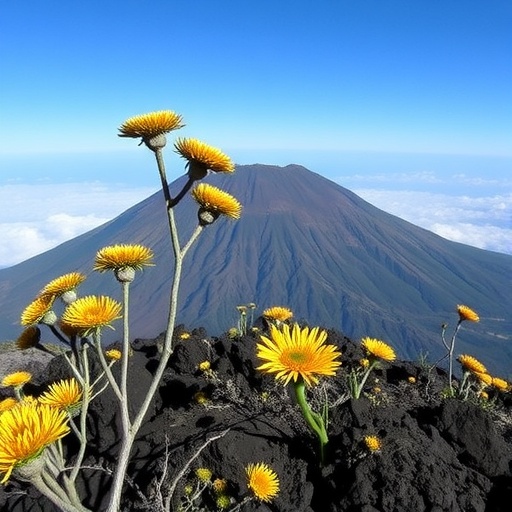A Century of Biodiversity Decline on Mount Kilimanjaro: Unveiling Human Impacts Over Climate Change
Mount Kilimanjaro, Africa’s highest peak and an iconic dormant tropical volcano, stands not only as a majestic natural landmark but also as an ecological hotspot. The mountain’s diverse ecosystems have supported human livelihoods for centuries, providing essential services such as timber, water regulation, and food. Yet, beneath Kilimanjaro’s scenic grandeur lies a pressing environmental crisis: a significant loss of biodiversity. Recent research conducted by Andreas Hemp and his multinational team from Germany, Switzerland, Japan, and Finland reveals that over the last century, the primary driver of this alarming biodiversity decline has been land-use change linked to human population pressures, rather than climate change, as commonly presumed.
In a comprehensive study published in PLOS One, Hemp et al. delve into the complex interactions between human activities and environmental wellbeing on the lower slopes of Kilimanjaro. Their work, grounded in rigorous observational methodologies, marries historical cartography with modern remote sensing and ecologically detailed datasets on nearly 3,000 plant species. This multi-decadal tale unpacks the causal mechanisms underpinning a staggering 75% reduction in natural plant species per square kilometer between 1911 and 2022, marking a sobering loss for one of the world’s most biologically rich tropical mountain environments.
This analysis was made possible through an unparalleled integration of remote sensing technologies, census data, and exhaustive ground-truthing of vegetation types. The team capitalized on high-resolution spatial data that allowed them to link human population density at a 1 km² scale directly with plant species distribution, a pioneering approach that provides granular insights into ecological shifts. The juxtaposition of these diverse data streams illuminated a clear narrative: rapid demographic growth coupled with expanding agricultural footprints and urban sprawl catalyzed large-scale conversion of natural habitats, predominantly savannas and forests, into human-modified landscapes.
Between 1913 and 2022, population density on Kilimanjaro’s lower slopes surged from approximately 30 to nearly 430 individuals per square kilometer. This exponential growth intensified land demand, prompting widespread habitat fragmentation and degradation. The researchers observed that such land-use transformations—often driven by subsistence and commercial agriculture—have been the dominant proximal causes of biodiversity loss. This finding contests dominant global discourses which tend to emphasize climate change as the overriding threat to biodiversity, suggesting instead that socio-economic factors must be foregrounded in conservation dialogues.
Interestingly, despite global concerns about the impacts of rising temperatures and shifting precipitation patterns in tropical zones, Hemp and colleagues found little direct evidence linking climate change to local biodiversity declines on Kilimanjaro. This result underscores the complexity of disentangling climate effects from intertwined anthropogenic pressures and highlights the necessity for context-specific analyses. It also points to potential resilience or lagged ecological responses to climatic stressors in this unique montane system.
Central to the paper’s message is a call for nuanced conservation policies that address the root socio-economic drivers of biodiversity loss. Hemp’s team points to traditional agroforestry practices and the establishment of protected areas as tangible examples of sustainable interventions already yielding benefits within the Kilimanjaro region. These practices balance human wellbeing with ecological integrity, offering promising pathways for mitigation amidst ongoing human development.
The study further emphasizes the crucial role of detailed biological collections and taxonomic expertise. The painstaking validation of ecological field data across diverse vegetation types was imperative to ensure accurate biodiversity assessments. The global collaboration with herbaria and biodiversity databases worldwide exemplifies how biosystematic research can underpin applied conservation science, particularly in regions where environmental data remain scarce.
Crucially, this research challenges prevailing narratives that singularly attribute biodiversity declines to climate change, advocating instead for integrated approaches that consider population dynamics, economic development, and land management. It suggests that effective conservation strategies must be multidimensional, spanning ecological, social, and political spheres.
Mount Kilimanjaro’s story, as told through this century-spanning lens, is both a cautionary tale and one of hope. While the scale of biodiversity loss is daunting, the identification of direct causes opens avenues for targeted action. Ensuring the resilience of Kilimanjaro’s ecosystems will require policies that limit further habitat loss, foster sustainable agricultural practices, and empower local communities.
Moreover, this research highlights the critical importance of long-term data and methodological innovation in understanding ecological change. By leveraging historical and modern datasets in tandem, the authors offer a blueprint for similar assessments on other tropical mountains, potentially influencing conservation paradigms at regional and global scales.
In summary, the findings from this landmark study underscore that addressing biodiversity loss on Kilimanjaro—and by extension, many tropical ecosystems—necessitates confronting human-driven land-use change head-on. Climate change remains a vital concern for global biodiversity, but this work serves as a timely reminder that socio-economic pressures continue to exert profound and immediate impacts on natural environments.
As the pressures on Kilimanjaro mount, the study advocates for integrated mitigation strategies that recognize the complex reality of human-environment interactions. Empowering traditional agricultural systems and expanding protected areas emerge as concrete, actionable solutions to preserve the mountain’s unique ecological heritage for future generations.
Subject of Research: People (Human Drivers of Environmental Change)
Article Title: Gain and loss: Human and environmental wellbeing – drivers of Kilimanjaro’s decreasing biodiversity
News Publication Date: 29-Oct-2025
Web References: http://dx.doi.org/10.1371/journal.pone.0334184
References: Hemp A, Miyazawa M, Hurskainen P (2025) Gain and loss: Human and environmental wellbeing – drivers of Kilimanjaro’s decreasing biodiversity. PLoS One 20(10): e0334184.
Image Credits: Anthony Lewis (www.anthony-lewis.com), PLOS, CC-BY 4.0
Keywords: biodiversity loss, land-use change, Mount Kilimanjaro, tropical mountains, human population growth, ecological change, agroforestry, protected areas, remote sensing, plant species diversity, conservation policy




